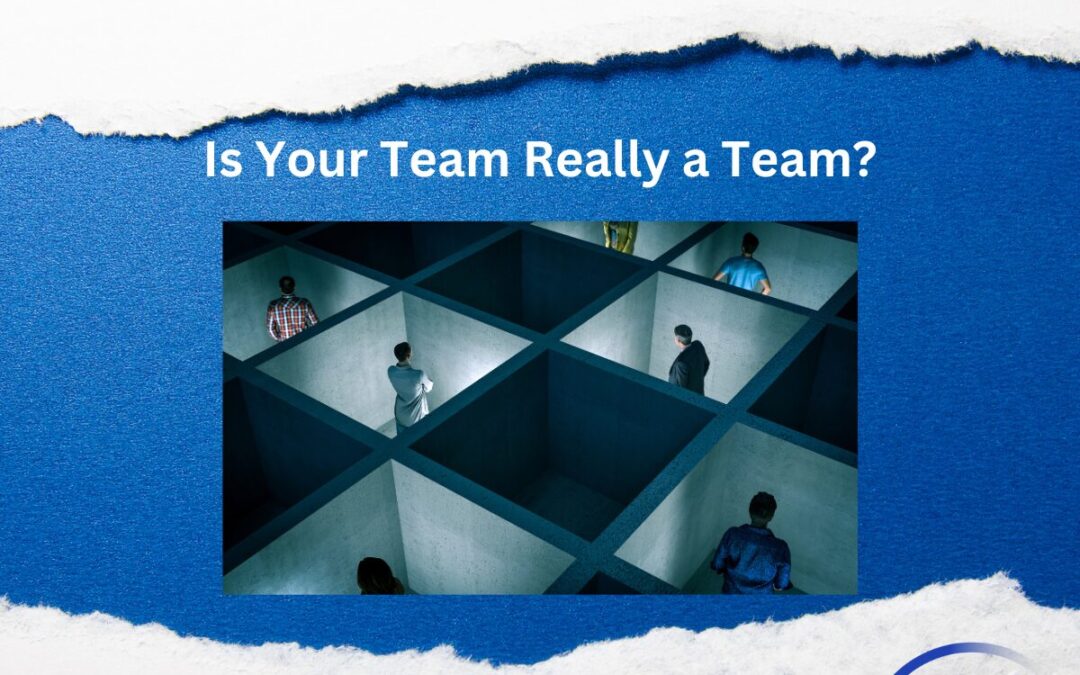Teams. We have all been on them! The definition of a team according to Webster is “”a number of persons associated together in work or activity”. I don’t know about you, but this seems more like the definition of a group! I remember long ago when I taught a course called Leading and Developing High Performance Teams, that a few key words added to the above sentence made more sense. From a leadership perspective, if you simply add the words interdependently and common goal to this sentence, it would better define what a team is: a group of individuals who interdependently work towards a common goal or objective, with specific roles and responsibilities. My bet is that most people within their organization are merely members of the first definition and not the second. Keep reading to find out if this is true for you!
Building a collaborative team is fundamental to achieving outstanding top results in any organization. However, there are telltale signs that might indicate your team isn’t functioning as effectively as it could be. From lack of collaboration to a silo mentality, recognizing these signs early can help you take corrective action. I want to explore some of the key indicators that suggest your team might actually not be a “team” but a group.
Collaboration is More Exception Than Rule
In a well-functioning team, collaboration is the foundation of day-to-day operations. If you notice that team meetings are dominated by monologues rather than dialogues, or if projects often get completed individually without input from others, it might signal a lack of true teamwork. Effective teams thrive on the exchange of ideas and mutual support where the success of one is the success of all.
Questions for leaders: How often do I actively seek out the opinions and ideas of others in my team? Do I encourage open dialogue in team meetings, or could I be more inviting to diverse perspectives?
Silo Mentality
A classic sign of a fragmented team is when individuals or groups within the team operate in silos. This means that communication flows vertically within these small groups but rarely crosses boundaries to include others. Such divisions can lead to duplicated efforts and a lack of synergy, severely hampering the team’s overall effectiveness and morale.
Questions for leaders: Do I know what individuals and sub-teams are working on and how it relates to the overarching vision and goal? What steps could I take to break down barriers and promote cross-departmental collaboration?
Accountability Isn’t Shared
In successful teams, members hold each other accountable in a constructive way. If accountability becomes a game of pointing fingers or disregarding responsibilities, then it’s a clear indicator of a problematic team dynamic. This environment can create a culture of blame and discourage risk-taking, which is essential for innovation and growth.
Questions for leaders: How do I react when there are setbacks in the team? Do I contribute to a culture of blame or support? What can I do to create a sense of shared responsibility and constructive accountability within my team?
Turnover Tells a Tale
High turnover within a team or an organization can be a major red flag! While it’s normal for team members to come and go, a consistent pattern of departures might indicate deeper issues. Often, this could be due to a lack of support, unrecognized efforts, micromanagement or a toxic team culture. Listening to exit interviews can provide critical insights into the health of future team dynamics.
Questions for leaders: Have I noticed patterns or common reasons why team members leave? What changes can I implement to make our team a more supportive and engaging place to work?
Decisions Are Dictated, Not Discussed
When decisions consistently come from the top-down management without involving those who will be most affected by them, it can demoralize a team. This approach can stifle, and even halt, initiative among team members and make them feel undervalued, thus reducing their commitment and engagement.
Questions for leaders: Does my team feel involved in the decision-making processes that affect our work? How can I improve the inclusiveness of the decision-making process in our team?
Feedback is Feared
In high performing teams, feedback is a regular and welcome part of continuous improvement. If your team members seem to dread feedback sessions or if these sessions are infrequent and unstructured, it may prevent the team from reaching its full potential. Creating a team where feedback is constructive, and a routine part of growth processes is crucial for goal attainment and forward progress.
Questions for leaders: How comfortable do I feel giving and receiving feedback within my team? What can be done to create a safer and more constructive environment for feedback to thrive?
A True Team Environment
Recognizing these signs is the first step towards turning a group of individuals into a true team. Each issue presents not just a challenge, but an opportunity to improve and transform your team dynamics. Engaging openly with these problems and addressing them through strategic team-building activities, leadership development, and transparent communication can help forge a stronger, more unified team.
As you reflect on these points and consider which areas your team could improve upon, and which one your team struggles with. Leaders, the bottom-line question you should ask yourself is, How can you facilitate a more inclusive, collaborative, and supportive team environment? As always, I appreciate you reading. Please share with anyone you think might enjoy reading this and find me on social to continue the conversation!
#TeamDynamics #LeadershipGoals #WorkplaceCulture #EffectiveTeams

